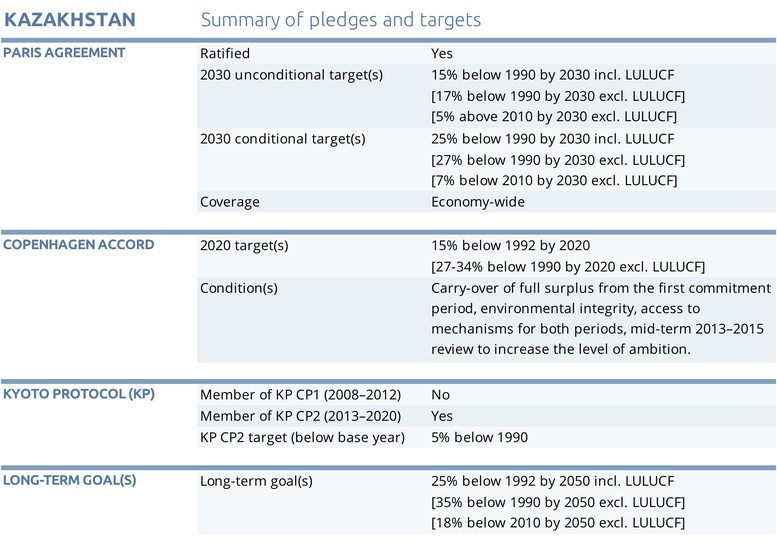Pledges And Targets
Summary table

Paris Agreement target
Kazakhstan signed the Paris Agreement on 2 August 2016 and ratified on 6 December 2016. Kazakhstan’s unconditional NDC target aims to reduce GHG emissions by 15% below 1990 levels (including LULUCF) by 2030. After accounting for LULUCF, using projections from the latest National Communication and UNFCCC inventory data, Kazakhstan’s target is equivalent to 17% below 1990 levels by 2030 excluding LULUCF (Republic of Kazakhstan, 2013, 2019).
The NDC does not specify the LULUCF accounting method it will use. For simplicity, and in the absence of other information, this assessment assumes a net-net approach to accounting for LULUCF activities. The size of Kazakhstan’s removals from the LULUCF sector are projected to remain at around 2012 levels (Republic of Kazakhstan, 2013). From this trend, future LULUCF removals are expected to have a minor impact. Kazakhstan also has a conditional target to reduce emissions (including LULUCF) by 25% below 1990 levels by 2030 (equivalent to 27% below 1990 levels, excluding LULUCF, by 2030). This target is subject to “additional international investments, access to low carbon technologies transfer mechanism, green climate funds and flexible mechanism for country with economy in transition” (Republic of Kazakhstan, 2016a).
Kazakhstan has stated it may use international market mechanisms to meet its NDC target, and that it “will consider adequately discounting international units for compliance to ensure a contribution to net global emission reductions” (Republic of Kazakhstan, 2016a). The impact of international market mechanisms on Kazakhstan’s NDC is not taken into account in this analysis.
2020 pledge and Kyoto target
Under the Copenhagen Accord, Kazakhstan proposed to reduce emissions by 15% below 1992 levels (incl. LULUCF) by 2020 (equivalent to an emission reduction of 27-34% below 1990 levels excluding LULUCF).
Kazakhstan submitted a QELRO1 (Quantified Emission Limitation or Reduction Objective) level of 95 for Kyoto Protocol’s second commitment period (CP2). This means that Kazakhstan’s average annual emissions from 2013–2020 are proposed to be 5% below 1990 levels. Kazakhstan’s intention to commit to this QELRO was conditional on being allowed to carry over its full surplus from the first commitment period, environmental integrity of the Kyoto Protocol, access to mechanisms for both periods and on a mid-term 2013–2015 review to increase the level of ambition in terms of emissions reductions among others.
However, paragraph 3.7ter of the Doha Amendment imposes a more ambitious emission reduction target on Kazakhstan, as countries joining CP2 need to at least stabilise emissions in 2013–2020 to the average historical emission level over 2008–2010.2 This leads to a Kyoto pathway that is almost 77 MtCO2e per year lower than the direct translation of their target for the period 2013–2020. As of November 2019, Kazakhstan has not ratified the Doha Amendment, meaning that this commitment is not yet binding on Kazakhstan under international law.
1 | The QELRO, expressed as a percentage in relation to a base year, denotes the average level of emissions that an Annex B Party could emit on an annual basis during a given commitment period.
2 | This is part of the Doha decisions and constitutes part of the amendments to the Kyoto Protocol. Amendments only come into effect once they are ratified by Parties.
Long-term goal
Kazakhstan has proposed a 2050 target of 25% reduction below 1992 levels excluding LULUCF (equivalent to an emission reduction of 35% below 1990 levels excluding LULUCF).
Further analysis
Latest publications
Stay informed
Subscribe to our newsletter




